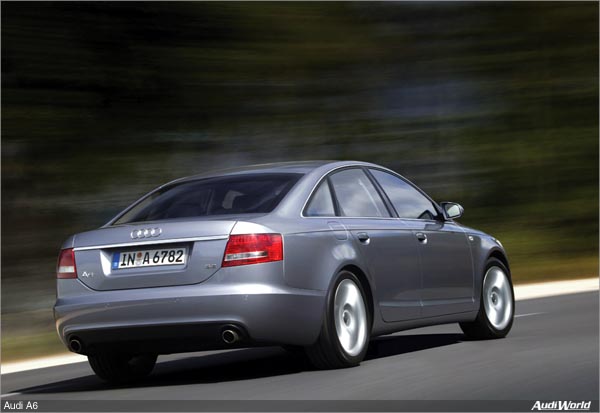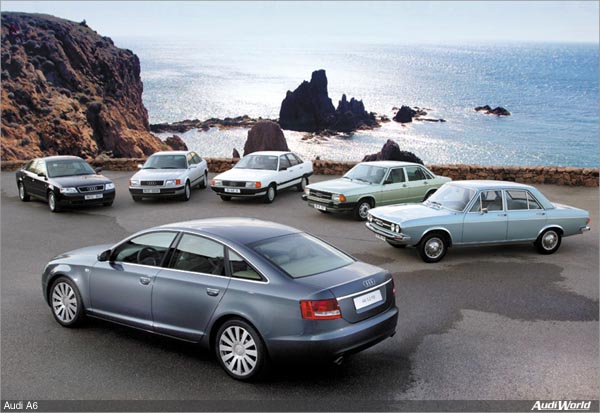The New A6: Market and Predecessors

Market Production of the former-generation Audi A6 referred to internally as the “C5” was well over one million units by the end of 2003. Indeed, approx. 1.2 million A6 saloons and A6 Avants of the C5 series are expected to come off the production lines in Neckarsulm and at the Chinese Plant in Changchun by the end of production – certainly a very remarkable achievement in the premium car segment. Worldwide, the saloon versions account for approximately 60 percent of this total volume. Focusing now on the new A6, Audi’s marketing strategists have set themselves even more ambitious targets: thanks to the superior qualities of the new car, they are confident that volume will be up by approximately 10 percent. Growth of this kind is certainly quite realistic, even in a global market hardly expanding, thanks to the outstanding qualities of the new model in terms of the product itself, its design and performance. Sales of the new Audi A6 saloon in 2004 are expected to amount to 70,000 units. Then, as of 2005, the worldwide capacity available will be approximately 180,000 units going to customers. Purchasers of the new Audi A6 are generally between 40 and 50 years of age, men accounting for more than 90 percent of all purchasers. The typical A6 purchasers being self-employed or high-level managers (apart, of course, from corporate customers). The largest sales markets for the new Audi A6 are not just in Europe. While approximately 31 percent of all the saloons built will remain in Germany, it appears likely that almost one out of every four new A6 models will go to China, following a growing trend. The USA and Canada, in turn, will account for 15 percent of production, Italy, Great Britain, Spain, and France being the most significant European export countries, each with a share of up to five percent in overall volume. It is also to be expected that more than 50 percent of all new Audi A6 models will be fitted with quattro permanent four-wheel drive, automatic transmission models likewise accounting for more than 60 percent versus the manual gearbox and multitronic models. In Germany the manual gearbox and automatic versions will achieve roughly the same volume, each with a share of approximately 50 percent. Looking at the engines, the new 2.0 and 3.0 TDI diesel versions are expected to account for the largest share in sales at 60 percent. The two 2.4 and 3.2 FSI six-cylinder petrol models then come next in Audi’s global sales plans, together accounting for 40 percent of the total sales volume.
Predecessors: A consistent story of success Introducing the first Audi 100, Audi started its consistent process of rising up into the luxury performance and upmarket segments. Each generation of the so-called C model meant one step further in the direction of building a premium model. The first “new age” Audi, a modified version of the DKW F 102, was presented back in autumn 1965 – albeit at the time with a newly developed four-stroke power unit. This was the result of a project initiated by Chief Development Engineer Ludwig Kraus with the intention, against some sceptical forecasts, of building a larger car. The development code was “C1” This very first version of the Audi 100 was launched in 1968 – and featuring front-wheel drive, a medium-pressure engine, and a particularly stiff and sturdy lightweight body, the new car immediately set new milestones. Output of the two first versions was 80 and 90 bhp, respectively. In autumn 1970 the Audi Coupé S, developing an output of 112 bhp, entered the market as a special sports model, with regular increases in power and modified front end design as of 1974 keeping the model series highly attractive for a long time. The second generation launched in 1976 boasted the looks of a four-door saloon with modern styling as well as extra-large headlights and rear lights. And indeed, this new model – the C2 – clearly marked out Audi’s path in becoming a trendsetter in technology: as of April 1977 the top model featured the world’s first five-cylinder power unit with fuel injection built in a large production series. Developing maximum output of 136 bhp, this 2.2-litre combined the refinement of a six-cylinder with the superior economy of a four-cylinder power unit. An important milestone in the C2’s story of success was the introduction of the first Audi 100 Avant in August 1977, back then a sports saloon in fastback design. The first diesel engine introduced by Audi came in 1978, the 2.0-litre 70 bhp five-cylinder combining superior fuel economy with a very long cruising range. The Audi 200 entered the market as the top model in 1979, the flagships in the family being characterised by luxurious features, sophisticated technology, and powerful engines. In the Audi 205T a 170 bhp turbocharged five-cylinder ensured absolutely outstanding performance. Introducing the C3, Audi offered the market a car setting up new world records not only in terms of aerodynamics. Rather, this was a perfect combination of consistent lightweight engineering, on the one hand, and an extremely aerodynamic body Launching the fully galvanised car body as the next highlight, Audi then set yet another standard versus the competition, proving the qualities of lasting value and a long service life. And for the first time the Audi 100 was now available with quattro permanent four-wheel drive, Audi giving a revolutionary idea the breakthrough it deserved in both rally racing and series production. Yet another trendsetter was the first passenger car with a five-cylinder TDI engine presented by Audi in 1989. Initially scorned by the competition, this direct-injection turbodiesel quickly proved its critics wrong, setting out on an impressive story of success thanks to its unique combination of powerful torque and unprecedented fuel economy. In the meantime nearly all manufacturers worldwide have changed over to this concept, clearly confirming Audi’s “Vorsprung durch Technik” and pioneering spirit. The fourth generation of the Audi 100 made its debut in late 1990, the most important features of the C4 being the powerfully designed, aerodynamic body and a new, agile wide-track suspension. The newly developed six-cylinder bore clear testimony to the higher position now achieved by the entire model series, the S4 and S4 Avant entering the market in autumn 1991 setting the foundation for the S models as high-performance versions with quattro drive. The final touch was added in 1992 by the Audi S4 4.2 powered by a 280 bhp 4.2-litre V8. Changing names: in the mid-90s Audi introduced new model designations clearly underlining the status of this progressive premium brand – the Audi 100 became the Audi A6, the new name ensuring a clear, international status. A further purpose of these new model designations was to emphasise the straightforward, timeless elegance of the cars and to provide a margin for including new models in the range. To be visionary and emotional – this was the objective with the fifth generation seeking to further strengthen Audi’s progressive prestige. And entering the market in 1997, the C5 with all its sporting and dynamic qualities certainly lived up to this objective. Apart from its revolutionary technologies, the new car excelled in particular through its wide range of modern engines as well as transmission and drivetrain options. Both the first six-cylinder TDI power unit and multitronic, Audi’s innovative, continuously variable automatic transmission, made their world debut in the C5. Offering up-to-date power units from four to eight cylinders, the A6 successfully met virtually all customer desires in terms of power and performance. The Avant version, in turn, was quickly acknowledged as a sporting lifestyle estate, prompting Audi to consistently expand this model series. Then, starting in 1999, the S6 and S6 Avant hit the headlines with their particularly dynamic 340 bhp V8 power unit. As of early 2002 quattro GmbH took this concept a step further, this very special Audi subsidiary launching the RS 6 based on the A6: a thoroughbred sports car in saloon and Avant clothing, combining enough room for a big family with exceptional performance on the road. Taking on the guise of the Audi allroad quattro entering the market in early 2001, the A6 also became fit for rough terrain. With its height-adjustable chassis, air suspension and quattro drive featuring additional locks, the allroad quattro is a genuine professional under tough off-road conditions and also looks good on the road, offering a high standard of practical comfort. Sales of the C5 and its derivatives now amount to more than one million units. This is precisely also the ambitious objective that Audi is setting itself with the new model which is likewise being groomed for leadership in the executive segment – with the goal once again of writing history in the world of motoring. |

